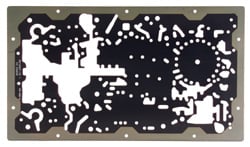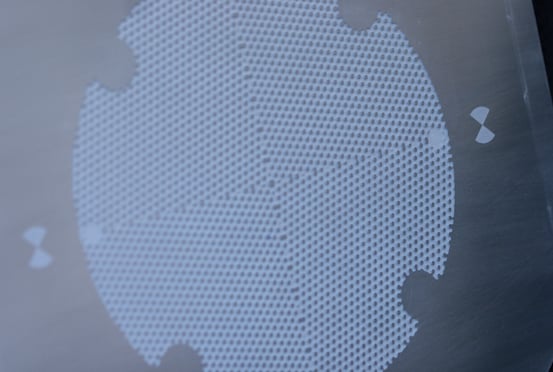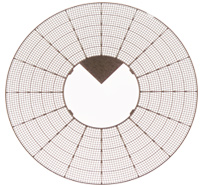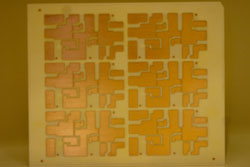What's Hot in Photo Etching
When the heat is on, many look to photo etching to move it around or make something useful of it--like electricity.
One of the oldest thermal applications for etching is heat sinks, devices that help remove heat from vulnerable electronic components. Heat sinks are generally passive devices, relying on air conduction to radiate heat away. Etching offers the ability to create pin- or vane-like structures that increase the effective radiating surface area without increasing the actual footprint of a device.
- Etched aluminum circuit board heat sink

- Etched aluminum "pin fin" radiator plate

"Cold plates" get an assist from a transfer medium such as anti-freeze to absorb excess heat and shuttle it away to be chilled and recycled. In a conventional radiator, the coolant is carried in tubing, often surrounded by metal vanes to help dissipate heat. In a cold plate the tubing is replaced by etched channels in copper or aluminum plates that are bonded together channel-to-channel to create tubes, of a sort, through which coolant is pumped.
Power generation and storage are also beneficiaries of the capabilities of photo etching. Fuel cells, batteries and evolving distributed generation technologies require part geometries that are uniquely realized by chemical etching.
Proton exchange membrane (PEM) fuel cells take advantage of photo etching's agnosticism with regard to part complexity vs. cost to produce very intricate membrane elements for both generating electricity and electrolyzing water to produce hydrogen.
Nickel-metal hydride and lithium ion power cells are the batteries of choice for space-based applications. Both rely on photo etching for critical components.
- Etched nickel cell grid for NiMH batteries

Thermal cycles are also useful in power generation. The "waste heat" of combustion is captured and converted to "work" (in the parlance of thermodynamics) as an additional stage of generation, often through steam turbines.
However, a number of evolving strategies are taking advantage of the ability of photo etching to create complex partial-depth etched structures and patterns that are central features of new distributed power generation technologies that take advantage of thermal cycles without the rotating machinery.
There are growing applications in power electronic components that are built on direct bond copper circuit materials. These are constructions of aluminum oxide (alumina) or aluminum nitride ceramic that have copper foil diffusion bonded on both sides. The ceramic dissipates the heat generated by the device, enabling both higher power applications and longer service life.
Etched direct bond copper on ceramic power electronics base

A long-time application for etching is in flexible resistive heating elements. Typically an electrically conductive material such as Inconel, stainless steel, nickel or copper is bonded to a non-conductive substrate such as silicon rubber, fiberglass or a polymeric material such as polyimide or polyester. The element pattern is etched into the metal down to the substrate, and the resulting circuit is usually affixed with electrical leads and encapsulated with another layer of non-conductive material. These types of devices find many applications in aircraft, both as de-icing boots for leading edges of the airframe or propellers, as well as preventing freezing in other systems on board.
Etched Inconel on silicon rubber flexible heater element

So, if you have a "hot" situation, you can keep your cool with photo etching. Contact us for more information.
For more detailed information on photo chemical machining, download our free comprehensive guide:


